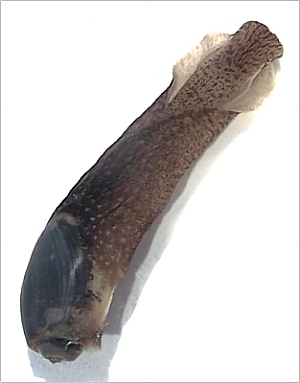
Akera bullata
Muller, 1776
Order: ANASPIDEA
Superfamily: AKEROIDEA
Family: Akeridae
DISTRIBUTION
Known from NE Atlantic coast of Europe and the Mediterranean
PHOTO
Langton Hive Point, the Fleet, Dorset, UK, 25 mm long alive, June 2003. Photo: Helen C. Marshall
Akera bullata is quite similar in shape to Akera soluta from the Pacific. They are very primitive Sea Hares [see Akeroidea Fact Sheet] and have a bubble-shaped external shell, an elongated neck-head region, and parapodia which fold over on each side to partially enclose the body. They spend most of their time crawling or burrowing in fine mud on sheltered shores and bays, but at time form swimming swarms, often in quite large numbers. They swim rather awkwardly with their heavy (shelled) end hanging down, rather like large heavy beetles flying. Can grow to 5 - 6 cm in length.
-
Morton, J. E. and Holme, N. A. (1955) The occurrence at Plymouth of the marine opisthobranch Akera bullata, with notes on its habits and relationships. Journal of the Marine Biological Association, United Kingdom 34: 101-112
-
Thompson, T.E. (1976) Biology of opisthobranch molluscs. Vol. 1. Ray Society No. 151, London. 207 pages.
Best wishes,
Bill Rudman
Rudman, W.B., 2006 (July 14) Akera bullata Muller, 1776. [In] Sea Slug Forum. Australian Museum, Sydney. Available from http://www.seaslugforum.net/find/akerbull
Related messages
Looking for live Akera bullata
November 20, 2009
From: Jeffrey S. Prince
We are investigating the evolution of the sea hare ink gland by ultrastructural comparison with other sea slugs and to finish this work we need a living specimen of Akera bullata sent [will pay shipping and handling and acknowledge in papers individuals involved] when they are available in the natural environment.
This work is being conducted in the Dauer Electron MIcroscopy Laboratory, University of Miami, Coral Gables FL. 33124.
Jeffrey S. Prince
jeffprince@miami.edu
J S Prince, 2009 (Nov 20) Looking for live Akera bullata. [Message in] Sea Slug Forum. Australian Museum, Sydney. Available from http://www.seaslugforum.net/find/22828Dear Jeffrey,
I suspect this is the wrong time of year for A. bullata.
If anyone can help please contact Jeffrey directly.
Best wishes,
Bill Rudman
Re: Akera bullata swimming
April 21, 2008
From: Clare & Dick Donovan
Concerning message #17136:
Hi
Having found this site we thought you should know that there are a large number of these animals currently swimming around in Sovereign Harbour, Eastbourne, UK. We'd never seen these before today (April 20th 2008) so did some research via Google and found this site. They are clearly Akera bullata.
Locality: Sovereign Harbour (marina in Eastbourne), variable but creatures seen in shallow water on surface, East Sussex, UK, English Channel, 20th April 2008, man made marina. Length: varied between 15mm and 30mm
regards
Clare & Dick Donovan
dick@bechar.plus.com
Donovan, C. & R., 2008 (Apr 21) Re: Akera bullata swimming. [Message in] Sea Slug Forum. Australian Museum, Sydney. Available from http://www.seaslugforum.net/find/21538Dear Clare & Dick,
Thanks for the information. Like their relatives, the sea hares, when Akera is present it usually occurs in large numbers. Unfortunately it can never be guarateed to be present when 'needed'. So if there is anyone in southern England who would like a specimen or two for DNA this might be a good time for a visit to Eastbourne.
Best wishes,
Bill Rudman
Re: Akera bullata swimming
August 6, 2007
From: Barry Drinan
Concerning message #20112:
Saw the same sea slug swimming close to the surface in Dun Laoghaire Marina, Co. Dublin Ireland. about two weeks ago. Had never seen anything like it before and only identified from an old marine biology text book. Definitely Akera bullata.
Locality: Marina, Very close to surface in 3 metres of wate, Dun Laoghaire, Co. Dublin, Ireland, Irish Sea, 6 July 2007, Tidal Harbour. Length: about 3 cms
Barry Drinan
drinanb@indigo.ie
Drinan, B, 2007 (Aug 6) Re: Akera bullata swimming. [Message in] Sea Slug Forum. Australian Museum, Sydney. Available from http://www.seaslugforum.net/find/20347Thanks Barry,
Bill Rudman
Re: Akera bullata swimming
July 5, 2007
From: Wellington Grey
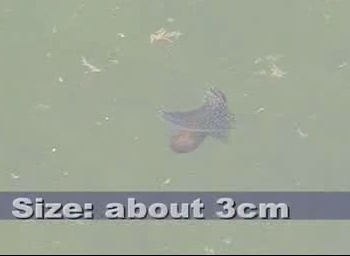
Concerning message #17136:
I've captured a small video of a creature in Portsmouth in April that I think is this creature. Is it possible to confirm that it is Akera bullata?
http://one.revver.com/watch/319013
Locality: Portsmouth, Surface, England, April 2007. Length: 3 cm
Wellington Grey
Grey1618@Googlemail.com
Grey, W., 2007 (Jul 5) Re: Akera bullata swimming. [Message in] Sea Slug Forum. Australian Museum, Sydney. Available from http://www.seaslugforum.net/find/20112Dear Grey,
Your video has caused a flurry of correspondence. I have had 6 people alert me to it from various parts of the world and have included a frame from the video with your message. It is definitely Akera bullata.
Best wishes,
Bill Rudman
Akera bullata from French Mediterranean [2]
June 20, 2007
From: Sylvie Grall
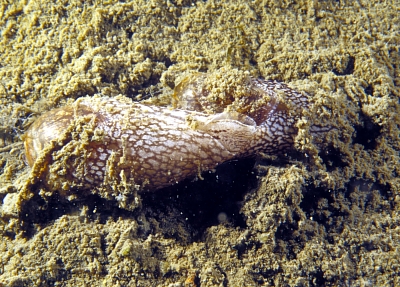
Concerning message #20044:
Dear Bill,
To accompany my contribution on Akera bullata and its ecology, here are photos of it mating. We meet this species every year in the Etang de Thau in the Mediterranean when they come out of the mud to breed. It takes place in March/April depending on the conditions. They appear as adults (we never saw small individuals) and seem to feed on the bottom. There is for a very short time (it seems to last only a few days) when we see them swimming up without obvious reason. After this they disappear again and we can find empty shells around.
Locality: Seawater lake, 8 m, France, Mediterranean, 14 april 2007, Muddy. Length: 8 cm. Photographer: Sylvie Grall.
Thank you.
Sylvie.
sylvgrall@aol.com
Grall, S., 2007 (Jun 20) Akera bullata from French Mediterranean [2]. [Message in] Sea Slug Forum. Australian Museum, Sydney. Available from http://www.seaslugforum.net/find/20050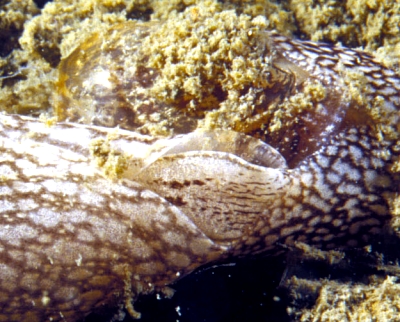
Dear Sylvie,
I have split you message in two so we have a better look at this photo of two animals mating.
As I discussed before, Akera, although a primitive sea hare, has many features in common with the cephalaspidean bubble shells, with a large external shell and a hermaphrodite reproductive system in which the female opening is at the opening of the mantle cavity on the right side, within the shell opening, and the penis is at the front of the body on the right of the head. As I described in your last message [#20044], there is an external groove to carry the sperm from the female genital opening forward to the penis. When mating takes place these animals do not sit right side to right side like nudibranchs, but the animal acting as the male must have its head up on the right side of its partner so the penis can be in contact with the female genital opening. That is what we can see in the close-up photo alongside - the head of the animal in the foreground is acting as the male and has the front of its head squeezed in between the right parapodia and the shell of the animal behind which is acting as the female.
Best wishes,
Bill Rudman
Akera bullata from the French Mediterranean
June 20, 2007
From: Sylvie Grall
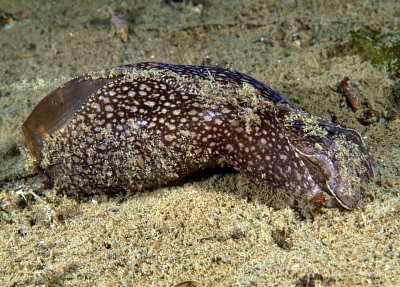
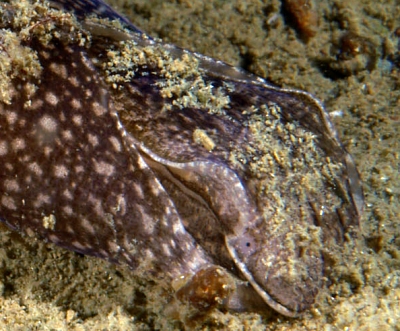
Concerning message #19999:
Dear Bill,
I'd like to include my contribution on Akera bullata and its ecology as we meet this species every year in the Etang de Thau in the Mediterranean when they come out of the mud to breed. It takes place in March/April depending on the conditions. They appear as adults (we never saw small individuals) and seem to feed on the bottom. There is for a very short time (it seems to last only a few days) when we see them swimming up without obvious reason. After this they disappear again and we can find empty shells around.
I am sending you a picture of Akera bullata seemingly feeding (or it may have been looking for tracks of its kin). It was moving the head on the sides while moving on.
Locality: Seawater lake, 8 m, France, Mediterranean, 14 april 2007, Muddy. Length: 8 cm. Photographer: Sylvie Grall.
It seems strange that it should feed on red algae, as it is spending most of its life in the mud. Or we may not have seen at the right time. I have also included a picture of a couple. The eggs look very much like those of Aplysia but in smaller amount of whitish "spaghetti".
Do you have precise information on the Hancock organs?
Thank you.
Sylvie.
sylvgrall@aol.com
Grall, S., 2007 (Jun 20) Akera bullata from the French Mediterranean. [Message in] Sea Slug Forum. Australian Museum, Sydney. Available from http://www.seaslugforum.net/find/20044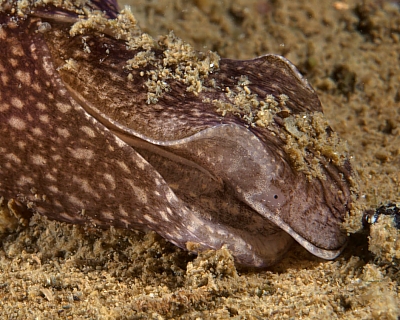
Dear Sylvie,
Thanks for the wonderful photos and information on this mysterious species. I guess the short period when it is seen is one of the reasons few people have studied it. Your description of it apparently arriving fully grown, breeding and then dying could be a description of what we know about many sea hares [see mass mortality page ]
Your mention of the Hancocks Organ reinforces the idea that many have had that Akera was actually a cephalaspidean 'bubble-shell' right up to Thompson in (1976). I remember discussing this with him but was unable to convince him that Akera was a proto-sea hare rather than a strange cephalaspidean. The Hancock's Organ is essentially a chemosdensoty organ found in cephalaspideans and consists of a sensory pad on each side of the head. I must make a point in preparing a page showing this organ. Umbraculum has a similar organ, also called a Hancock's Organ [see 3967], but its difficult to know if they are tthe same structure or not.
As I have said before, we don't know much about Akera, but one of the earliest studies (Guiart, 1901) is often ignored although it is extremely thorough and valuable. Guiart clearly realised the close relationship between Akera and the sea hares, In his anatomical account he describes a Hancock's Organ on each side of the head, in the groove between the head shiled and the foot. In your photo alongside it is the greyish brown band. It certainly is in the same place as in cephalaspideans and Guiart does describe some nerve branching to it, but I think we will need further work to see if it a chemosensory structure. Guiart calls the ear-like structures behind each eye as 'rudimentary rhinophores' and I would agree that they are the fore-runners of the sea hare rhinophore [see aplysiid head page]. In the aplysiids it is the rhinophores which have a chemosensory function, so it is possible there are chemosensory receptors on the ear-like flaps in Akera. If so, it would suggest the bands we are calling 'Hancocks Organs' in Akera are not these organs at all.
The other thing you can see in the close-up of the head is a whitish groove along the top of greyish band we are calling the Hancocks Organ. This is the sperm groove which carries the sperm from the female genital opening in the mantle cavity [which is back in the shell opening] forward to the penis which opens on the right side of the head. A similar groove can be seen in sea hares. I will talk more about mating in Akera in a separate message [#20050 ].
Concerning feeding, it is possible it does not normally feed on red macroalgae. I should have said in reponse to Helen Marshall's message [#19999] that there are a few exceptions to the red algae rule and they are Bursatella leachii and Stylocheilus striatus which feed on layers of 'blue-green algae' or cyanobacteria forming a layer of the sandy mud surfaces. This 'food' contains the chemicals needed to produce their red ink. Perhaps Akera also feeds on this layer. In my comments on Helen Marshall's message I said that Thompson & Seaward did not observe what Akera fed on, but I missed a couple of sentences where they say that in summer it fed on rafts of the green alga Enteromorpha and during the remainder of the year the brown gritty faeces suggested they fed directly on the sediment. [I have corrected my earlier comment].
-
Guiart, J. (1901) Contribution à l'étude des Gastéropodes opisthobranches et en particulier des céphalaspides. Mémoires de la Société Zoologique de France 14: 1-219, pls. 1-7.
Thanks so much for these interesting photos,
Best wishes,
Bill Rudman
Akera bullata from Dorset, UK
June 12, 2007
From: Helen C Marshall
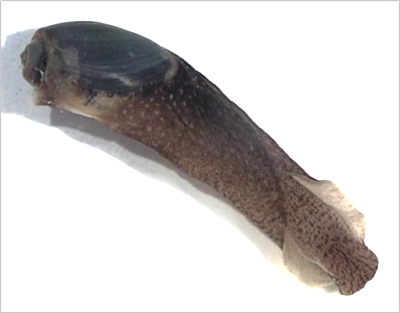
Dear Bill
I noticed that you didn't have any pictures of Akera bullata on the sea slug forum (except the picture of an adult swimming). Please find attached three pictures of A. bullata gathered from Langton Hive Point, the Fleet, Dorset, UK in June 2003. These are supposed to be var. nana, as reported by Thompson & Seaward (1989), although I'm not 100% convinced as they grew to a fair size in my aquarium at Swansea University and they produced ink when fed Chondrus.
It was 25 mm long alive.
-
Thompson, T. E. and Seaward, D. R. (1989) Ecology and taxonomic status of the aplysiomorph Akera bullata in the British Isles. Journal of Molluscan Studies 55: 489-496 .
Regards,
Helen
Dr Helen C Marshall
Institute of Biological Sciences
University of Wales Aberystwyth
hem@aber.ac.uk
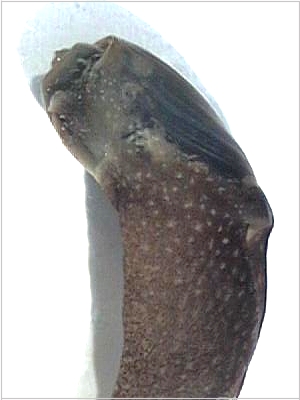
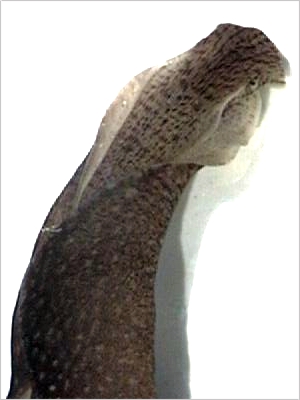
Dear Helen,
Thanks for these very welcome photos. Apart from D.P.Wilson's photos in Thompson (1976) of swimming animals I don't think I have seen photos of them crawling like this. Although externally they look nothing like a sea hare, their anatomy [see Fact Sheet] shows their close relationship. Their large external, thinly calcified shell, like those in many cephalasideans and sacoglossans, suggests that all these opisthobranch groups arose from ancestors in which the calcified external shell of a snail was gradually lost as they evolved into 'slugs'.
I am very interested to hear that it will eat the red alga Chondrus as I can find no information on its diet. Thompson & Seaward (1989) observed that in summer Akera fed on rafts of the green alga Enteromorpha and during the remainder of the year the brown gritty faeces suggested they fed directly on the sediment. Certainly aplysiids tend to prefer red algae and are facultatively 'de-inked' if they have no red algae in their diet. I would be interested to hear of any other information you have on its diet, because we have no information on the Indo-West Pacific species A. soluta.
-
Thompson, T. E. (1976) Biology of opisthobranch molluscs. London, Ray Society no. 151. 1-207.
Best wishes,
Bill Rudman
Re: Akera bullata swimming
July 20, 2006
From: Andrej Jaklin
Concerning message #17173:
Dear Bill,
I would just like to say that there are pictures of swimming Akera bullata in T.E. Thompson's book Biology of Opisthobranch Molluscs, Vol. I., (plates 16 & 17).
Best regards,
aj
jaklin@cim.irb.hr
Jaklin, A, 2006 (Jul 20) Re: Akera bullata swimming. [Message in] Sea Slug Forum. Australian Museum, Sydney. Available from http://www.seaslugforum.net/find/17176Thanks Andrej,
Best wishes,
Bill Rudman
Re: Akera bullata swimming
July 18, 2006
From: Ian Buzzard
Concerning message #17136:
Dear Bill,
Thank you for your reply and identification of the Akera bullata photos. I will try for better pictures when I next see them, and hope to catch one for a closer observation.
Thanks again,
Ian Buzzard
ian.buzzard@ntlworld.com
Ian Buzzard, 2006 (Jul 18) Re: Akera bullata swimming. [Message in] Sea Slug Forum. Australian Museum, Sydney. Available from http://www.seaslugforum.net/find/17173Dear Ian,
Good luck. If you get a chance, it would be nice to get some photos of it crawling as well.
Best wishes,
Bill Rudman
Akera bullata swimming
July 17, 2006
From: Ian Buzzard
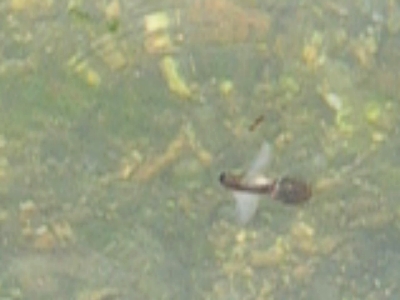
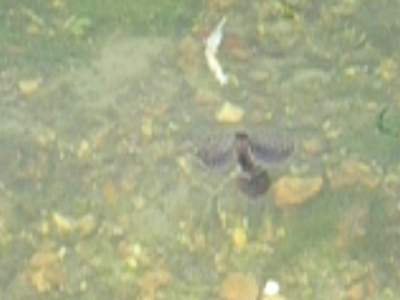
Never seen here before, moves along using umbrella-like vane opening and closing. Appears to rise to surface as if to breathe? then descends to bottom for a few minutes, and moves about looking like a bee in slow motion.There were about twenty of these at most, then they disappeared in June as weather got hotter. A lady at Blue Reef Aquarium at Southsea seemed to think it is a nudibranch, but did not know the particular type.The pics were extracted from video, so are not too clear.
Locality: Gosport, Hampshire, 1 to 2 feet, England, off The Solent, 24 May 2006, tidal creek, mostly salt. Length: 3 inches max. Photographer: Ian Buzzard.
Ian Buzzard
ian.buzzard@ntlworld.com
Buzzard, I.B., 2006 (Jul 17) Akera bullata swimming. [Message in] Sea Slug Forum. Australian Museum, Sydney. Available from http://www.seaslugforum.net/find/17136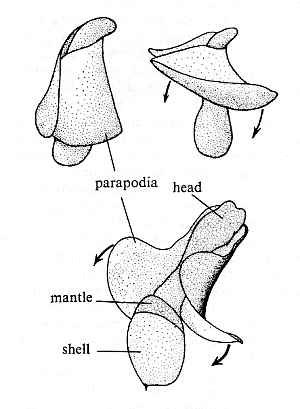
Dear Ian,
This is an interesting observation which has rarely been reported. The animal is Akera bullata, which is a very primitive Sea Hare rather than a nudibranch [see Akeroidea Fact Sheet]. They have a bubble-shaped external shell and although they spend most of their time crawling or burrowing in fine mud on sheltered shores and bays, they can at time form swimming swarms, often in quite large numbers. Some say swarming is involved with breeding, while others say it is the juveniles that usually swarm, but basically this 'swarming - swimming' behaviour has not been studied in detail and only reported in the scientific literature 3 or 4 times, so it is not possible to say anything very sensible about it. The drawing alongside is from Morton & Holme (1955) who report spawning and swimming from April-July in the English Channel coast. Theanimals swim rather awkwardly with their heavy (shelled) end hanging down, more like large heavy flying beetles, than bees. I haven't any photos of living Akera bullata, but it is quite similar in shape to Akera soluta from the Pacific.
-
Morton, J. E. and Holme, N. A. (1955) The occurrence at Plymouth of the marine opisthobranch Akera bullata, with notes on its habits and relationships. Journal of the Marine Biological Association, United Kingdom 34: 101-112
Best wishes,
Bill Rudman
